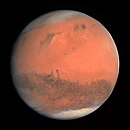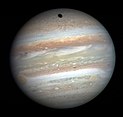Planets
A planet is an astronomical body orbiting a star or stellar remnant that is massive enough to be rounded by its own gravity, is not massive enough to cause thermonuclear fusion, and has cleared its neighboring region of planetesimals.[1]
Background
[edit | edit source]Etymology
[edit | edit source]The Greek planetes is the ancestor of the word "planet," meaning "wanderer."
History
[edit | edit source]Classical Planets
[edit | edit source]Known to various ancient cultures, antiquity's classical planets were the non-fixed objects visible in the sky: the Sun, Moon, and the five other planets of our solar system closest to the sun. These planets, all visible without a telescope, are Mercury, Venus, Mars, Jupiter, and Saturn.
As explained on Wikipedia, "The term planet in modern terminology is only applied to natural satellites directly orbiting the Sun, so that of the seven classical planets, five are planets in the modern sense."[2]
Uranus and Neptune
[edit | edit source]Uranus' discovery date was 1781, while Neptune's was 1846.[3][4]
Solar System
[edit | edit source]
| ||||
| The eight known planets of the Solar System, shown in order from the Sun and in true color. Sizes are not to scale. |
There are eight known planets of the Solar System, listed in order from the Sun:
Terrestrial planets
[edit | edit source]- Mercury, which is (relatively) near the sun, is small and in a way, overlooked. There are no smaller planets, though there are dwarf planets smaller than Mercury.
- Venus is known for its extreme heat and atmosphere, which keeps in the planet's high temperatures.
- Earth stands out for being habitable, contrasting it with the other planets.
- Mars is the location of a cold climate and stunning geographical features. There is hope that, in the future, astronauts will reach Mars.
Giant planets
[edit | edit source]Gas giants
[edit | edit source]- Jupiter, the largest of the planets, is known for its stormy weather and large number of moons.
- Saturn is also large, but it is better known for the stunningly dramatic and beautiful rings surrounding it.
Ice giants
[edit | edit source]- Uranus, which is rather awkwardly flipped sideways, is identified by its light green color.
- Neptune lies farthest out and possesses a blue color.
Exoplanets
[edit | edit source]An exoplanet or extrasolar planet is a planet outside the Solar System. The first evidence of an exoplanet was noted in 1917, but was not recognized as such. The first scientific detection of an exoplanet was in 1988; it was confirmed to be an exoplanet in 2012. The first confirmed detection occurred in 1992. As of 1 July 2019, there are 4,096 confirmed planets in 3,053 systems, with 664 systems having more than one planet.[5]
Gallery
[edit | edit source]-
Four of the planets in front of the sun: Jupiter, Saturn, Uranus, and Neptune[6]
-
The planets
See Also
[edit | edit source]Wikiversity
[edit | edit source]Wikipedia
[edit | edit source]References
[edit | edit source]- ↑ Wikipedia: Planet
- ↑ "Classical planet". Wikipedia. 2019-05-09. https://en.wikipedia.org/w/index.php?title=Classical_planet&oldid=896277200.
- ↑ "When were each of the planets first discovered and who did it?". starchild.gsfc.nasa.gov. Retrieved 2019-07-26.
- ↑ "When were Uranus and Neptune discovered". Answers.com. Retrieved 2019-07-26.
- ↑ Wikipedia: Exoplanet
- ↑ "Planet". Wikipedia. 2019-07-27. https://en.wikipedia.org/w/index.php?title=Planet&oldid=908084217.









![Four of the planets in front of the sun: Jupiter, Saturn, Uranus, and Neptune[6]](http://upload.wikimedia.org/wikipedia/commons/thumb/e/e1/Gas_Giants_%26_The_Sun_in_1%2C000_km.jpg/250px-Gas_Giants_%26_The_Sun_in_1%2C000_km.jpg)
